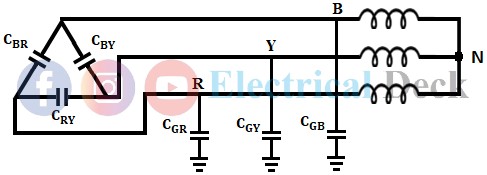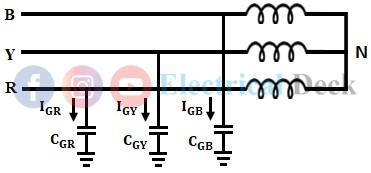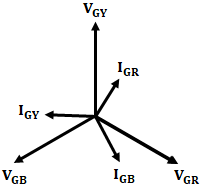The ungrounded neutral system is a neutral system in which there is isolation between neutral and ground i.e., there is no electrical connection between neutral and ground. Hence the ungrounded neutral system is also called an isolated neutral system or free neutral system or insulated neutral system.
Ungrounded Neutral System :
A simple 3-phase system with ungrounded is shown in the below figure. In reality, there exists a capacitive effect between one conductor to another and the line conductors also have a capacitance effect with the ground too. Thus capacitive currents flow in all the phases of the system.
In the above figure, the capacitors between conductor and ground are star-connected, whereas the capacitors between each conductor are delta connected. The capacitance value of the delta-connected capacitors can be neglected as they have no effect on the earth circuit.
During Normal Condition :
In normal operating conditions, the system is balanced and the capacitances to the ground are assumed to be equal i.e., CGR = CGY = CGB = CEC, where CEC is the capacitance of each capacitor to ground. From the above figure, it was said that the delta-connected capacitors can be neglected as they have no effect on earth, if so done then the figure above gets modified as shown in the below figure.
As the capacitance becomes equal in every conductor then the phase voltages also become equal (in magnitude) i.e., VGR, VGB, VGY, and hence the capacitance currents also become equal to Vph/Xc.
Under the normal operating conditions, the system is balanced i.e., all the line phase voltages will be equal in magnitude and have a phase difference of 120°. As the shunt capacitors of all the phases are the same, the corresponding charging current will also be equal. The currents will be equal in magnitude and have a phase difference of 120° as the system is balanced. Hence, the sum of these currents will be equal to zero.
We know that, the neutral current is,∴ IN = IR + IY + IB = 0Hence, there is no current flowing through the ground and therefore, the neutral and ground will be at the same potential under normal operating conditions.
During Fault Condition :
Let us assume that an L-G fault occurs on the system at some point F with the L-G fault in R, the potential of the R phase gets equal to ground potential, and due to this a short-circuit occurs in capacitance of line (i.e., CGR). Therefore no current flows through CGR.
The capacitive currents IGB and IGY flow through the phase lines B and Y respectively. The driving voltages of IGB and IGY are VGB and VGY respectively, moreover note is to be taken that VRY and VRB are line voltages. The two currents flowing i.e., IGY and IGB are having capacitive paths. Thus IGY leads VRY by π/2 and IGB leads VRB by π/2. The fault current IF in R is nothing but the sum of the two currents IGB and IGY.






